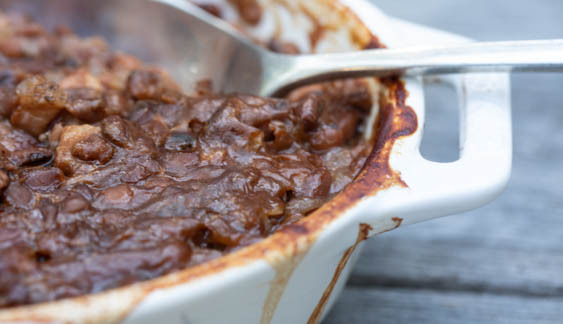Boston Baked Sea Island Red Peas

introduction
Boston baked beans typically start with Great Northern white beans and a slow oven-braise in chicken stock, with salt pork, onion, molasses, and spice. Over time the beans succumb to the flavors they’re offered and become tender, dark, and rich. They don’t need much attention.
We adore Boston baked beans and have long wanted to kidnap some Southern field peas and give them a bit of East Coast schooling and a new school uniform. We assumed the little peas, with their earthy pluck and mineral accents, would flourish in such an atmosphere. But they didn’t make it easy. Despite baking for hours, they refused to yield. (Dried field peas are a very dense legume!) They didn’t like molasses, either, but they took well to a little muscovado. We had to gentle them along, not simply with an overnight soak, but also a quick simmer, followed by a good thrashing—or rather, mashing—before setting them in the oven.
Then there was the little problem of the salt pork. Salt pork—the “pork” in pork ’n beans—is crucial to the character of baked beans. It is made by salt-curing raw pork belly, an old method of preservation. But, surprise, surprise! The commercial salt pork we purchased added nothing to the flavor of the peas, and the meat toughened as it cooked when it should have become tender. Because salt pork is cured and not smoked, its impact in a dish depends solely on the seasonings used to cure it and the quality of the pork itself.
You can see where this is going. Yes, we made our own.
The finished dish is delicate and rich—hot or cold. We schooled some field peas, and they schooled us.
Cooking Remarks
Salt pork is easy to make and unexpectedly delicious. We say unexpected because most people have never tasted good salt pork. We hadn’t. We purchased a nice piece of Berkshire pork belly and a stash of sea salt. Four days and very little effort later, we had salt pork. Its flavor frankly blew us away. But you don’t have to make your own salt pork to enjoy this recipe.
equipment mise en place
For this recipe, you will need a digital kitchen scale, a large bowl, a heavy-bottomed 3-quart saucepan, a potato masher, a baking sheet, a 10-inch skillet, and a shallow 1-quart baking dish.
-
-
7ounces (1 cup) Anson Mills Sea Island Red Peas
-
Spring or filtered water
-
2teaspoons unsalted butter
-
2.5ounces Salted-Cured Pork Belly or purchased salt pork, cut to ⅛-inch dice (½ cup)
-
1¼cups minced yellow onion
-
2teaspoons minced garlic
-
2teaspoons tomato paste
-
1½tablespoons (0.75 ounce) dark muscovado sugar
-
Tiny pinch of ground cloves
-
1cup Rich Homemade Chicken Stock or low-sodium chicken broth
-
¼teaspoon fine sea salt
-
½teaspoon freshly ground black pepper
-
-
In a large bowl, cover the peas with an abundance of water, at least 4 times their volume. Let them soak overnight at room temperature.
-
The next day, drain the peas and turn them into a heavy-bottomed 3-quart saucepan. Pour in 3 cups water and bring to a simmer over medium-high heat. Reduce the heat to medium-low and cook uncovered, stirring occasionally and adjusting the burner to maintain a gentle simmer, until the peas are tender and the water has evaporated to the level where it laps the edges of the peas, 30 to 40 minutes.
-
Using a potato masher, mash the peas selectively, leaving about half of them intact, until the peas have thickened and look creamy, but still rather saucy. Remove the pan from the heat, cover it and set it aside.
-
Adjust the oven rack to the middle position, place a baking sheet on the rack and heat the oven to 250 degrees. In a 10-inch skillet, combine the butter and salt pork, then cook over medium-low heat, stirring frequently, until the pork is crisp and golden and most of the fat has rendered, 5 to 7 minutes. Add the onion and sauté until it begins to soften, about 5 minutes. Stir in the garlic, tomato paste, cloves, and sugar; cook for about 10 seconds. Turn the mixture into the saucepan with the peas, then add the chicken stock, salt, and pepper. Set the saucepan over medium-low heat and cook, stirring, just until the peas are hot.
-
Turn the peas into a shallow 1-quart baking dish; the dish will be be quite full. Slide the baking dish onto the baking sheet in the oven and bake for 2 hours, stirring 3 or 4 times. The liquid will be significantly reduced and the top of the peas burnished and glazed. Let cool for about 20 minutes before serving.